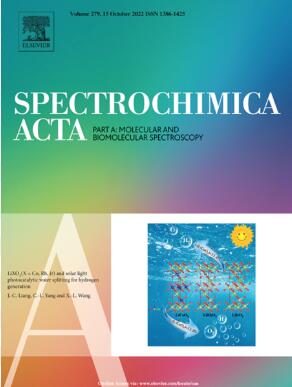A composite optical filter greenly fabricated for living algae detection
IF 4.3
2区 化学
Q1 SPECTROSCOPY
Spectrochimica Acta Part A: Molecular and Biomolecular Spectroscopy
Pub Date : 2025-06-04
DOI:10.1016/j.saa.2025.126533
引用次数: 0
Abstract
The integration of optical filtration functionality into a lens and a microfluidic chip represents a promising approach for reducing the size of a microfluidic device. Greenly fabricating a composite polydimethylsiloxane (PDMS) filter (C-filter) with optical amplification function for chlorophyll fluorescence detection was proposed in this work. The core idea is to make the PDMS microfluidic chip as one sub-filter (S-filter) and enable another sub-filter amplification function (F-lens). The S-filter was prepared by soaking a PDMS microfluidic chip into Sudan II dye solved with ethanol. The F-lens is manufactured by sequentially mixing ethanol-solved crystal violet and the dimethyl-methylhydrogenosiloxane and dimethyl-methylvinylsiloxane for lens molding. Experimental results show that ethanol can serve as an effective and green substitute for phenol and toluene for dye dissolving. The dimethyl-methylhydrogenosiloxane can well dissolve crystal violet. The S-filter can filter light within the wavelength range of 400–500 nm, while the F-lens can filter light in the wavelength range of 500–650 nm. The C-filter shows a transmittance of 99.33 % in the wave length range of 650–710 nm, which is superior to the 96.72 % transmittance of commercial filters and is well-suited for living algae detection.

绿色制备的用于检测活藻的复合滤光片
将光学过滤功能集成到透镜和微流控芯片中代表了减小微流控装置尺寸的有前途的方法。提出了一种绿色制备的具有光学放大功能的聚二甲基硅氧烷(PDMS)复合滤光片(c滤光片)用于叶绿素荧光检测。其核心思想是将PDMS微流控芯片作为一个子滤波器(S-filter),并启用另一个子滤波器放大功能(F-lens)。将PDMS微流控芯片浸泡在用乙醇溶解的Sudan II染料中制备s -过滤器。f透镜是通过将乙醇溶解的结晶紫与二甲基甲基氢基硅氧烷和二甲基甲基乙烯基硅氧烷依次混合制成透镜模塑的。实验结果表明,乙醇可作为苯酚和甲苯的有效绿色替代品用于染料溶解。二甲基甲基氢基硅氧烷能很好地溶解结晶紫。s型滤光片可滤光400 - 500nm波长范围内的光,f型滤光片可滤光500 - 650nm波长范围内的光。在650 ~ 710 nm的波长范围内,c型滤光片的透过率为99.33%,优于商用滤光片96.72%的透过率,适用于活藻检测。
本文章由计算机程序翻译,如有差异,请以英文原文为准。
求助全文
约1分钟内获得全文
求助全文
来源期刊
CiteScore
8.40
自引率
11.40%
发文量
1364
审稿时长
40 days
期刊介绍:
Spectrochimica Acta, Part A: Molecular and Biomolecular Spectroscopy (SAA) is an interdisciplinary journal which spans from basic to applied aspects of optical spectroscopy in chemistry, medicine, biology, and materials science.
The journal publishes original scientific papers that feature high-quality spectroscopic data and analysis. From the broad range of optical spectroscopies, the emphasis is on electronic, vibrational or rotational spectra of molecules, rather than on spectroscopy based on magnetic moments.
Criteria for publication in SAA are novelty, uniqueness, and outstanding quality. Routine applications of spectroscopic techniques and computational methods are not appropriate.
Topics of particular interest of Spectrochimica Acta Part A include, but are not limited to:
Spectroscopy and dynamics of bioanalytical, biomedical, environmental, and atmospheric sciences,
Novel experimental techniques or instrumentation for molecular spectroscopy,
Novel theoretical and computational methods,
Novel applications in photochemistry and photobiology,
Novel interpretational approaches as well as advances in data analysis based on electronic or vibrational spectroscopy.

 求助内容:
求助内容: 应助结果提醒方式:
应助结果提醒方式:


